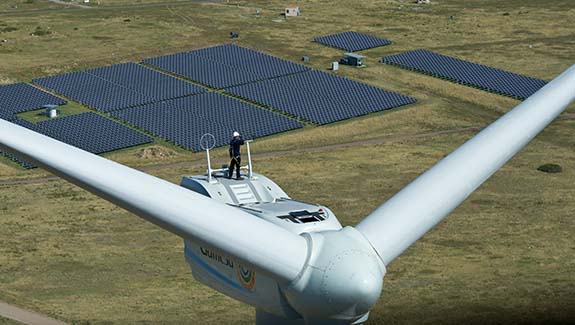Hybrid Energy Systems for Clean Energy Manufacturing
August 2, 2019—Coupling variable renewable energy sources, such as wind and solar, with battery storage is necessary to transition to a predominately renewable grid.

Solar and wind turbines working together at NREL's Wind Technology Center. Photo by Dennis Schroeder, NREL
The renewable energy industry is currently experiencing enormous growth in all sectors, including hybrid energy projects. Overall, renewable energy has grown to account for more than 33% of the world’s total installed power generating capacity. Solar PV has experienced the most rapid cost declines, as module prices have fallen more than 90% since 2010 (REN21, 2019). A strong correlation can be seen between the expected growth in battery storage, which has reduced in cost by 14% year over year, and the growth we have already seen in renewables (Ericson et al., 2017).
A ‘battery hybrid system’ refers to a power generation system that is operationally paired with a battery system, often to help overcome some of the cost/regulation limitations of standalone batteries (Ericson et al., 2017). Large commercial and industrial companies are turning to battery hybrid systems for 24/7 assured reliance of energy to keep their machinery and computer servers running.
For these manufacturing processes, the implications of a power loss can be quite extreme; for example, if a composite wind blade is under cure and a power outage occurs, the required pressure and temperature needed to cure the material will drop very quickly. If the bond lines holding the wind blade together are not cured or the composite materials are not fully cross-linked, then the blade will never reach its required strength. The resulting cost of a power loss mount in the matter of minutes and can be detrimental to the company’s delivery schedule and overall production cost if parts must be scrapped. While other industries with critical operations have similar concerns, in wind energy, aerospace, marine industries, and other very large and expensive manufacturing processes, reliable power can have a direct impact on the company’s bottom line.
This potential revenue loss would spur a push for the company to invest in large back-up diesel generators, which have historically been used as a back-up power source for these critical operations. However, battery hybrid systems are now emerging as a viable solution for providing clean back-up power to manufacturing industries. This is particularly beneficial for renewable energy companies who are manufacturing wind turbines, solar panels, or even battery storage systems. The employment of battery hybrid systems would save the company money while improving their image by implementing the products that they build into powering their manufacturing plants.
Hybrid energy systems offer multiple possibilities for industry; they could be utilized to keep critical machines running or server rooms from losing power by employing battery hybrid systems for back-up. Furthermore, large industrial facilities are usually located outside of cities where land is readily available, making it difficult for the utilities to maintain and support the grid infrastructure. Instead of relying on large back-up diesel generators, integrated battery storage can be coupled with wind or solar PV to create sustainable hybrid energy systems nearly anywhere in the world.
Ben Finell
This blog post is featured as part of our JISEA.org guest post series.
Back to JISEA News >
